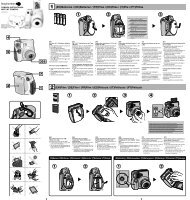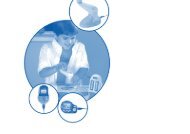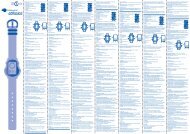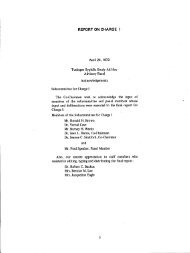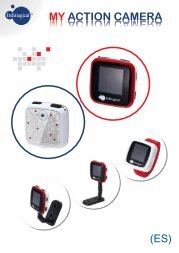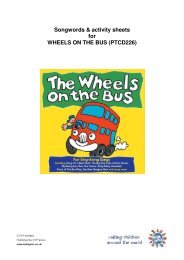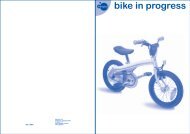Ref.: IMG-59419_080512 conservatory CLASSIC ... - Imaginarium
Ref.: IMG-59419_080512 conservatory CLASSIC ... - Imaginarium
Ref.: IMG-59419_080512 conservatory CLASSIC ... - Imaginarium
You also want an ePaper? Increase the reach of your titles
YUMPU automatically turns print PDFs into web optimized ePapers that Google loves.
<strong>59419</strong> Conservatory <strong>CLASSIC</strong> GUITAR ins.ai 8 6/1/2012 4:37:53 PM<br />
1.2. Neck:<br />
a. Frets<br />
b. Position markers<br />
c. Strings (1st, 2nd, 3rd, 4th, 5th, 6th)<br />
1.3. Resonance box<br />
a. Neck<br />
b. Mouth<br />
c. Bridge<br />
2. HOW TO PLAY<br />
2.1. The guitar can be played both standing up and sitting<br />
down. Try not to press your left wrist against the neck as this<br />
makes the fingers tense up and might cause them to ache<br />
after a while. The strings need to be pressed firmly but<br />
carefully and you should only play the strings required to<br />
make each note.<br />
There are two techniques for playing the guitar: "strumming",<br />
which is based on playing harmonies and various strings at<br />
the same time, and "plucking", which is playing single notes<br />
and strings one by one. We suggest starting with the plucking<br />
technique; that way you can play simple songs like the ones<br />
we include here.<br />
When playing in this way, you use your hands as follows:<br />
2.2. Left hand: this is the hand that forms the notes. Each<br />
finger, numbered 1, 2, 3 and 4, presses one string on a<br />
particular fret. For some notes you don't have to press any<br />
strings with your left hand; this is called playing open strings.<br />
Your thumb should rest on the back of the guitar neck and<br />
your fingers should be curved round so they reach the strings.<br />
Be sure to press the strings with your finger tips, just above<br />
each fret.<br />
2.3. Right hand: the strings are played by alternating between<br />
your second and third fingers (index and middle finger). You<br />
can also play using a plectrum (included). Hold the plectrum<br />
firmly between your thumb and index finger and pluck the<br />
corresponding string.<br />
3. THE STRINGS<br />
The first string is the one at the bottom when we are holding<br />
the guitar in the correct position. The sixth string is the one at<br />
the top. In the diagrams, the first string is on the right and the<br />
sixth string is on the left.<br />
4. THE FRETS<br />
There are 14 frets. The first fret is the one closest to the<br />
tuning pegs and the last one is the one closest to the sound<br />
hole.<br />
5. PREPARATION<br />
Before we start playing, we have to tune the guitar. The<br />
classic method for tuning a guitar is by ear and with the help<br />
of a tuning fork (not included), which gives you the note A. To<br />
tune your guitar you need to follow a number of rules:<br />
- First tune the fifth string, played openly, to the pitch of the<br />
tuning fork. The two should sound as similar as possible.<br />
- Now, the 6th string pressed down on the 5th fret should<br />
sound the same as the 5th string when played openly.<br />
- The 5th string pressed down on the 5th fret should sound the<br />
same as the 4th string when played openly.<br />
- The 4th string pressed down on the 5th fret should sound the<br />
same as the 3rd string when played openly.<br />
- The 3rd string pressed down on the 4th fret should sound<br />
the same as the 2nd string when played openly. It is important<br />
to remember this difference.<br />
- The 2nd string pressed down on the 5th fret should sound<br />
the same as the 1st string when played openly.<br />
The strings can be tightened or loosened by moving the pegs<br />
one way or the other.<br />
To begin playing the songs we suggest, you must first prepare<br />
your guitar and place the coloured stickers in the positions<br />
shown in the diagram. The position of the coloured sticker<br />
indicates that it is on that string and that fret where you should<br />
press down with your left hand. If the sticker is located before<br />
the bridge, this means that you play the open string and<br />
therefore you do not need to press any strings with your left<br />
hand.<br />
Bear in mind that the guitar has three octaves, that is, it starts<br />
with E on the lowest scale and goes up to G on the highest<br />
scale.In this diagram the notes appear in the same order as<br />
they do on the guitar and show the correspondence between<br />
the notes, their names in English and the colours:<br />
E<br />
F<br />
G<br />
A<br />
B<br />
C<br />
D<br />
E<br />
F<br />
G<br />
p.8<br />
A<br />
B<br />
C<br />
D<br />
E<br />
F<br />
G<br />
This manual enables you to play using only the colours and<br />
also by reading the staves for those who want to learn this<br />
system.<br />
As well as knowing the notes, we also have to play the right<br />
rhythm. To help understand the rhythm patterns, we can look<br />
at the position of each note in the stave. The length of each<br />
note is expressed as follows:<br />
½ beat (equals a "quaver")<br />
1 beat (equals a "black" figure)<br />
2 beats (equals a "white" figure)<br />
3 beats (equals a "white figure with a dot”)<br />
4 beats (equals a "round" figure)<br />
6. SONGS<br />
Now you can begin to play the songs we suggest.<br />
(FR)<br />
ItsImagical a créé Conservatory, une gamme consacrée à<br />
l'initiation musicale pour les enfants de 4 à 6 ans. Une<br />
méthode d'apprentissage musical à partir de couleurs, simple,<br />
naturelle et motivante, qui leur permettra de découvrir les<br />
bienfaits de l'apprentissage de la musique pendant l'enfance.<br />
Sa première guitare espagnole est une vraie guitare adaptée<br />
à sa taille.Pour jouer, composer et se découvrir une passion<br />
pour la musique.<br />
La guitare est un instrument à cordes pincées, composé d'une<br />
caisse en bois, d'un manche sur lequel est adossée la touche,<br />
avec un trou acoustique au centre (rosette) et six cordes. La<br />
touche est divisée en cases, qui permettent de jouer les<br />
différentes notes. C'est l'instrument le plus utilisé dans des<br />
genres comme le blues, le rock ou le flamenco, ainsi que dans<br />
le folklore de différents pays.<br />
1. ÉLÉMENTS DE LA GUITARE<br />
La guitare est composée des éléments suivants :<br />
1.1. Tête<br />
a. Clefs d'accordement<br />
b. Sillet<br />
1.2. Manche :<br />
a. Cases<br />
b. Frettes<br />
c. Cordes (1ère, 2e, 3e, 4e, 5e, 6e)<br />
1.3. Caisse de résonance<br />
a. Cou<br />
b. Rosette<br />
c. Chevalet<br />
2. COMMENT JOUER<br />
2.1. On peut jouer de la guitare debout ou assis. Il ne faut pas<br />
appuyer le poignet gauche contre le manche, car cela surtend<br />
les doigts et finit par causer une gêne. Il faut appuyer<br />
fermement sur les cordes en faisant attention de ne toucher<br />
que celle qui correspond à la note souhaitée.<br />
Il existe deux techniques pour jouer de la guitare : le «<br />
grattage », qui consiste à jouer des accords en touchant<br />
plusieurs cordes en même temps et le « pincé », qui consiste<br />
à jouer des notes isolées, en touchant les cordes une à une.<br />
Nous te proposons de commencer par la technique du<br />
pincement, qui te permettra de jouer des morceaux simples,<br />
comme ceux que nous fournissons dans la méthode.<br />
Les mains travaillent de la manière suivante :<br />
2.2. Main gauche : c'est celle qui marque les notes. Chaque<br />
doigt (ils sont numérotés 1, 2, 3 et 4) se charge d'appuyer sur<br />
une corde, sur une case déterminée. Certaines notes se<br />
jouent sans appuyer sur aucune corde de la main gauche, on<br />
dit alors qu'on joue la corde « à vide ». Tu dois poser le pouce<br />
sur la partie arrière du manche et courber les doigts pour<br />
atteindre les cordes. Veille à bien pincer les cordes du bout<br />
des doigts, presque au bout de chaque case.




